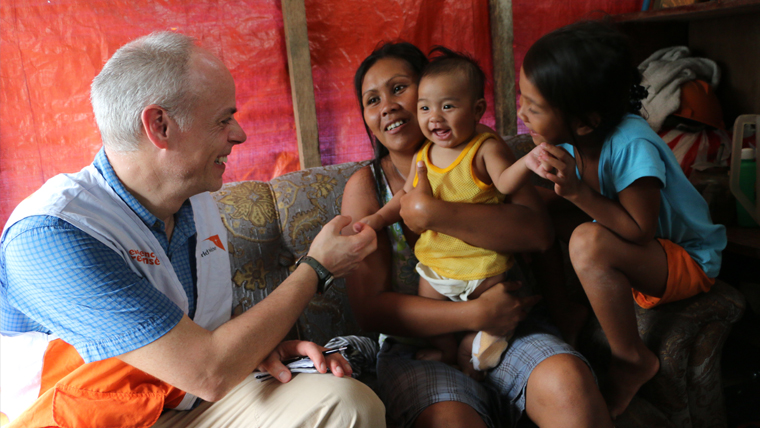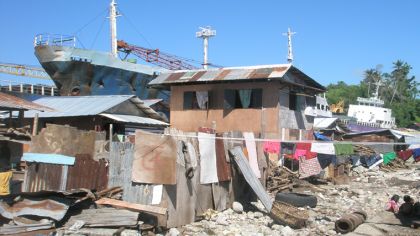Tacloban Rises

By Justin Byworth, Chief Executive, World Vision UK
There are some places in the world whose names have become synonymous with an event or a time. An otherwise unnoticed place where an extraordinary, often tragic moment of humanity has unfolded that propels it onto the world stage. Just the mention of Darfur, Srebenica, Helmand or closer to home Lockerbie or Dunblane conjures up powerful images and meaning.
Tacloban is one such place. Last November, this small coastal town on the Philippine island of Leyte flooded our television screens with images of death and destruction that shocked the world and prompted an outpouring of public generosity.
Three months on from Typhoon Haiyan and Tacloban is starting to rise up, as signs saying “Tacloban Tindog” across the town proclaim in the local Waray-Waray language.
Contrasting scenes
It is the contrast of the unimaginable devastation and the gentle natural beauty that strikes me most on my first day here in Tacloban.
The mile after mile of crumpled buildings, twisted metal, broken concrete, mounds of debris, uprooted trees and mass graves are almost impossible to describe. Yet this is set against a mountain background of gentle tropical green forest and rice paddy.
Tacloban’s mothers and children convey an even more potent contrast, of immense suffering and loss, and yet a fierce dignity and determination.
Sherianne lives under the twisted wreck of a massive communications mast that was once over 120 feet tall but now looks like a wilted flower, bent double by the force of the winds and the sea water which surged up and over Tacloban.
All the homes around her were destroyed and I’ve never seen anything quite like her neighbour’s family who have made a new home in the upside down bowl of a radio dish hanging down from the broken mast.
Sherianne walked me through the wreck of her home and showed me how she crouched in the corner with her family huddled in her arms until the water was too strong and swept them out. She waved her arms as she described how the communications mast waved around in the wind before crashing down.
“Thank God it fell away from us not on top of us, I was crying and praying. I don’t know how we survived.”
Ships not at sea
 A few miles north is a sight of complete incongruity. Hundreds of families living in the shadow of an enormous ship that the storm thrust aground, smashing its way through a swathe of homes.
A few miles north is a sight of complete incongruity. Hundreds of families living in the shadow of an enormous ship that the storm thrust aground, smashing its way through a swathe of homes.
“My home was over there – right under the ship,” says Wellaa, a mother of four who’s now living a hastily erected shack between the ship and the sea. “We evacuated to the school before the typhoon hit but my father in law couldn’t make it, when we came back we found his body, naked washed up above the ship. We were thankful though to find his body, many others didn’t.”
In this small cluster of homes alone 28 people lost their lives. Yet amidst this tragic and bizarre community, somehow the normality of life continues. Little Luigi, only 2 years old pokes his stick at the wooden struts underneath the ship, imitating the men beside him with their sledgehammers.
A local woman organising the clearance of debris as part of another agency’s ‘cash for work’ scheme leads me to a tiny local ‘sari sari’ store which has re-emerged, where I buy a bottle of coke.
The resilience of the Filipino people is legendary and I’ve seen it time and time again here this week.
Jocelyn and Reggie
Reggie was not even a month when typhoon Haiyan hit. His mother Jocelyn told me, “I wrapped the baby up and climbed the hill behind our home. I watched from above while a huge body of water collapsed all the trees and houses.”
While Jocelyn left for a few days with her sister, her husband Reynaldo went to work immediately constructing a new home in the ruins of their old one. Reynaldo is a fisherman but had received carpentry training from World Vision and with his tools, the debris from the storm and a temporary tarpaulin roof from World Vision it was only two weeks before they were back in their new makeshift home.
Reynaldo’s fishing boat was swept away in the typhoon but he’s hopeful that his carpentry skills can earn them money with so much reconstruction needed.
Reggie has been sick and Jocelyn is full of thanks for the water purification tablets she received today from World Vision along with a hygiene kit and jerry can, “We need clean water to keep our children safe, the deep well is far away and not so clean.”
World Vision is repairing the water supply in her village, with the water tank that blew down in the typhoon dented but back up and working and we’re now putting in 6 taps with one just a few metres from Jocelyn’s home.
Reggie’s brother and sister are making the most of the Child Friendly Space that World Vision’s established here. Jenny, who’s 6, tells me “I like the toys there, especially the Barbie doll” and says her brother Rap Rap, who’s 3, likes the football.
Sitting with this beautiful young family amidst the noise of a tropical downpour on their tarpaulin roof as Jenny sings and Rap Rap plays with his ball, I am overwhelmed at their strength and love and the way such simple help from World Vision has woven together to impact their lives in a truly transformational way.
The spirit of Tacloban
Tacloban may have become famous worldwide for its scenes of physical devastation and loss, the likes of which I’ve not seen in over 25 years in humanitarian work. But in the Philippines at least Tacloban is now becoming famous for the spirit of its people – as the “I love Tacloban” t-shirts I saw many wearing today say: “Strong faith. Good family. Proud nation.”
For all of us who gave, prayed and played a small part in helping such extraordinary people overcome such overwhelming odds it is truly humbling.
If you'd like to see some of the things Justin has written about, click over to our YouTube channel to watch his video blogs from his visit to the Philippines.
